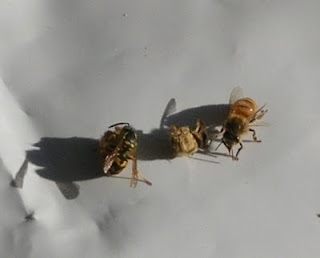Just reviewed “single comb harvest” segment on the video by BackYardHive which describes removing one honey comb when the bees have drawn comb on the last bar in the hive. In this hive, B16 is the one to watch. One systematically goes through the combs beginning at the back of the hive, detaching “brace” comb, which adheres the honey comb to the side for stability, looking for a comb that is ¾ filled with capped honey. Bees are drawing comb now on B15 so it may be that they will have enough space this year. I will check every few days to see when a comb is started on B16 and how fast they are drawing and then decide whether to remove a honey filled comb. We should be getting to the end of honey flow, but there a lot of bees in the hive still and they do keep busy.
I have a different mindset re yard plants now that we have the bees to consider. They are not attracted to marigolds, buckwheat, crimson clover (as mentioned earlier), and geraniums in the yard. They do like the chives, all mints, sedums, michaelmas daisies, black-eyed susans, squash, cucumber, green bean, chard, and raspberry blossoms found in our yard now. Purchased about ten different bee attractive perennials at the nursery yesterday; planted for glorious blooming next summer. Time to start making notes about what is blooming when that our bees find worthwhile. Obviously they forage further than our yard, but it’s neat to see them working close, too.
While visiting the hive early this morning I saw a bee carry something away from the hive and shortly after a drone was dropped out of the hive onto the ground below. Looking closer, I saw its wings were gone…drones being expelled apparently. Placed a piece of white plastic under the hive to be able to better see what was happening on the ground. Soon another drone fell and a hive bee landed on top of it and began taking it apart. Immediately a wasp flew in and took over one part as soon as it was separated. The hive bee flew away with part of the carcass and the wasp stayed with its part…interesting.
 |
| Wasp arriving after drone dropped. |
 |
| Drone parted into two sections. |
 |
| Hive bee removing its section. |
Lots of pollen being brought into the hive. The bees seem to take it through the two main entrances and not through the bottom opening; some nectar bearing bees enter through the bottom as well as through the main entrances. Somewhere I read that bees have to offload pollen themselves whereas nectar is transferred from one bee to another until it is deposited into the cell…also interesting.
Created another veil…black netting this time, which is much easier to see through than white. I use ¾ yard of regular nylon netting and sew a side seam on the short side and a casing on the long side for elastic. It easily slips over the crown of a brimmed hat. Now visitors can use the extra veils to get a good look at the hive if they are timid around bees, which is to be expected because that’s what most of us have learned.
Back to really hot weather for us, 90’s for several days again. Here are pictures of the awning setup, at 9 a.m., noon, and 3p.m.
 |
| 9 a.m. shade |
 |
| Noon shade |
 |
| 3 p.m. shade |
Many bees outside the hive tonight about 7:30p when neighbor Ernie stopped by to see the backyard hive; he has many years of commercial beekeeping experience in the central valley of
California. Ernie suggested the hive needed more ventilation so I removed the ¾” spacer and the 3 entrance plugs on the back of the hive. Already had raised the roof to allow air movement across the bars but it was still too hot in the hive. Shortly after the spacer was removed, bees began moving back into the hive. Interesting information from Ernie about bees being on the outside of the hive—hornets will come along and snatch bees, which agitates those left…not a good thing.
Also, Ernie noticed ants on the sides and top of the hive and said they irritate the bees. I’ll have to find something to get rid of them. We have so many ants that I don’t see being able to rid the yard of them; may have to figure out a ‘moat’ to keep them away from the hive.
I offered to show Ernie the inside of the hive while removing the spacer; he thought I might not want to do that. I said the bees were calm around me and I proceeded to lift B16, the end topbar. And a bee flew out and stung my finger…again. Ernie said one doesn’t disturb the hive after evening because the bees are more aware of intruders. Guess so—and they’re not busy working elsewhere. We talked about how bees get used to the hive keeper’s scent, but that doesn’t matter once evening is here. Okay, now I know yet another thing about beekeeping…it’s a daytime activity!
Because of its size, this is considered a swarming hive; this is good as one purpose of backyard hives is to help bees repopulate. Ernie said there will be a big swarm from this hive next spring, which is nice to know since I planned to split it next spring.
So glad he stopped by…more news is that there will be two more beekeepers in our airpark soon. They are getting established hives from someone who can no longer keep them. And he will be harvesting about 300# of honey from his two Langstroth hives soon. I’m looking forward to seeing that happen and to seeing the extraction process. So nice to have an experienced beekeeper neighbor.




















